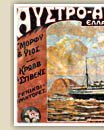
This development continued until it was completed in the period under examination. Thus, despite
the dramatic decrease in the number of ships between 1875 and 1895, the tonnage of the merchant fleet
actually increased, a natural reflection of the different qualities
of the two types of ships. The following table illustrates this:
Table: Sailing ships and Steamers 1875-1915
| Year |
1875 |
1895 |
1915 |
Number
Sailing ships |
5.410 |
1.059 |
884 |
Tonnage
Sailing ships |
253.781 |
246.196 |
107.466 |
Number
Steamers |
37 |
107 |
475 |
Tonnage
Steamers |
8.241 |
144.975 |
893.650 |
Total ships
(Sailing ships + Steamers) |
5.447 |
1.166 |
1.359 |
Total tonnage
(Sailing ships+ Steamers) |
262.022 |
391.171 |
1.001.116 |
Source: N. Svoronos, Episkopisi tis Neoellinikis Istorias,
Athens, Themelio editions, 1992 (13th edition), p. 100.
It is evident that between 1895 and 1915 the number of steamers grew fourfold and their tonnage
sixfold. The merchant navy catered for both foreign and domestic trade, including domestic transport,
mostly conducted through coastal lines. A large number of Greeks originating from the islands or coastal
areas were engaged in shipping and their salaries were high (10 million francs in 1902, 20 million in 1912), that contributed much to the
improvement of the financial state of the country. In 1923 approximately 30,000 seamen
were employed in steamers.
In 1912 Greece was the second largest power in the trade of the Black Sea after Great Britain, whereas
in 1914 she was the 10th country (6th on the basis of its population) in sea-going shipping. In the First
World War shipping suffered considerable losses: from the one million tonnage
it possessed in 1915, it fell to only 400,000 in 1918. This did not mean a decrease
in the profits of shipowners, which in certain cases amounted to 1 billion French francs.
Greek shipping made up for its losses very quickly, reaching
a tonnage of 1,315,473 as early as 1928.
In general, the profit from shipping was often invested abroad for reasons
of speculation but also as a means of tax evasion. It is typical that in the late
1910s shipowners refused to accept regulations concerning the taxation of their profits
from the war.
|
 |
